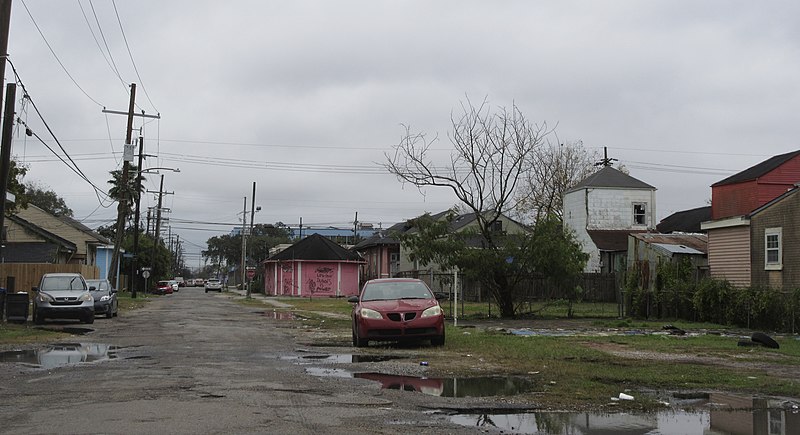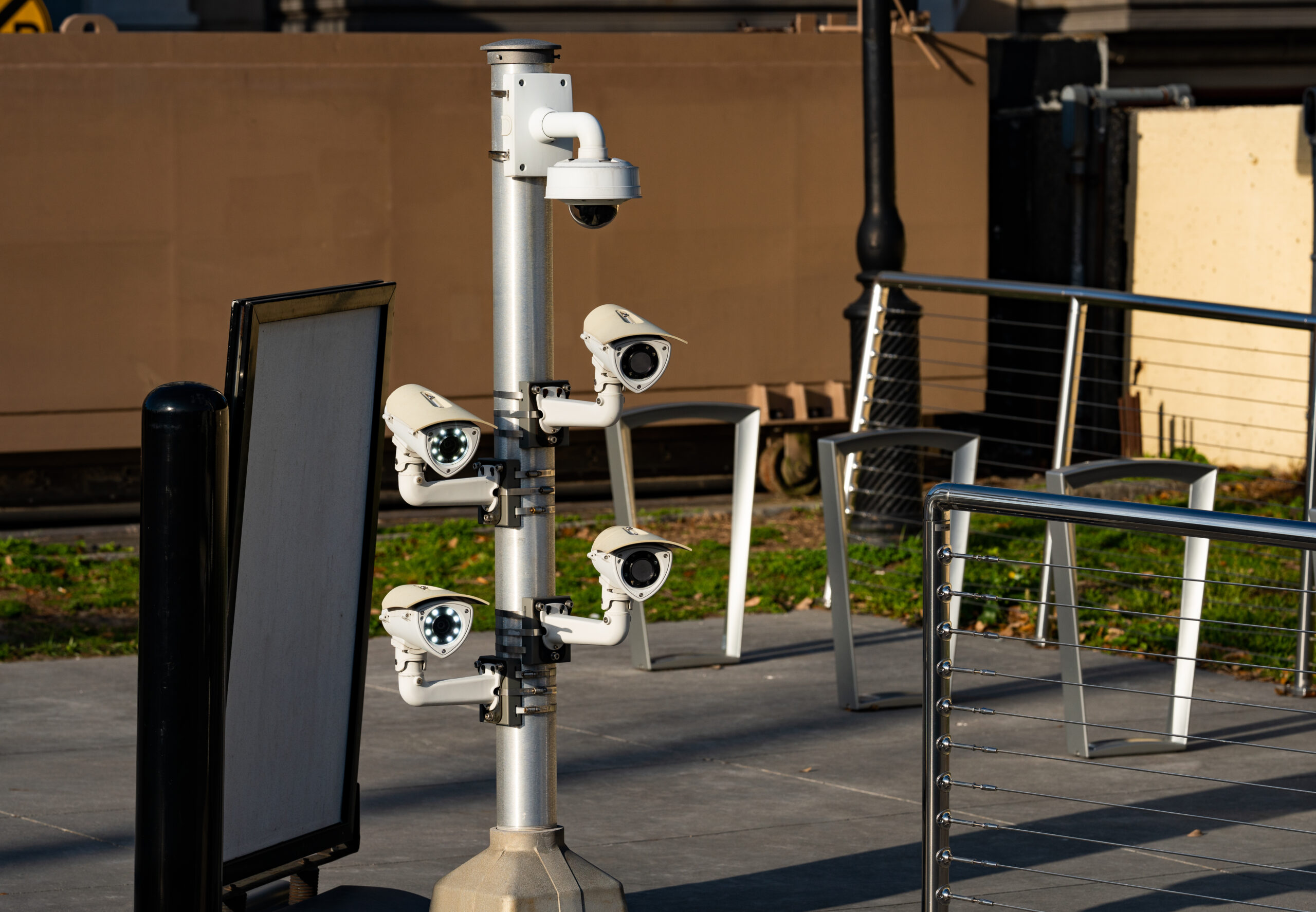
The Seventh Ward in 2018.
Photo by: Wikipedia
Picture this: you’re visiting New Orleans for the first time and you decide to drive through the city. You begin with the French Quarter, and ride through visions of laid-back musicians and lively white people dining at restaurants, such as GW Fins, where entrees are strictly above $30 and you cannot enter unless dressed head to toe in a suit or other elegant fashion. Then maybe you drive down St. Charles and see the beautiful mansions and white families walking their dogs. Lastly, you pass through the Seventh Ward: there are dozens of “boarded-up homes and weed-covered lots”, broken window glass shattered, houses simply without their front door, and a policeman on every corner. If you’re a nonpartisan person, you most likely steer clear of the Seventh Ward.
The Seventh Ward holds a median household income of around $25k, which is almost less than half of the average income in the general Orleans Parish. Additionally, only 23.1% of the Seventh Ward’s population receive a higher degree than a high school diploma, which, again, is almost half of the count in New Orleans as a whole. On top of this, Valenca C. Jones Elementary School, one of the main public schools in the Seventh Ward, has literally been considered a war zone, as the classrooms hold shattered glass, smashed fluorescent lights, and half tore down walls. By contrast, New Orleans Center for Creative Arts, a local high school situated in Bywater, a newly gentrified neighborhood, is freshly renovated with amenities that support all of the academic needs of its students, such as science labs, classical instrument training, culinary arts programs, and musical theater equipment.

A Classroom Inside Valena C. Jones Elementary School.
Photo by: Ariella Cohen
Not coincidentally, the Seventh Ward holds the highest rate for murders in New Orleans, as of 2019, solidifying the neighborhood as a hotspot for crime. Today, there are 91 commissioned officers assigned to the district, the most officers assigned to any district, according to Chief Ferguson. On top of this, New Orleans has majorly expanded surveillance cameras; the state has plans to set them up on every block with active operations 24 hours daily. Increased police surveillance is certainly not new to New Orleans; taxpayers pay a sum of 2.8 million dollars annually to cover the costs of the city’s surveillance cameras. However, despite the increased surveillance, the Seventh Ward remains riddled with crime. Where is the justification for expanding the police force in this neighborhood?
According to media activist, Malkia Cyril, surveillance and policing “reinforce the subordinate status of enslaved people,” as citizens are demoted to subordinate figures within society, stripped of their basic human right to privacy. Likewise, the primary basis of the police institution began as slave patrols, “enforcing segregation and the disenfranchisement of freed slaves”. Has this system really changed? Absolutely not. The police department systematically utilizes their power to exploit the black community for minor crimes, ultimately threatening public safety instead of securing it.
The history of police strikes in New York City perfectly exemplifies how the police department does not decrease crime. In 2015, New York City police officers went on a seven-week strike in an attempt to avenge the death of Eric Garner, a black male choked to death by a white policeman for selling cigarettes without a stamp. During the strike, the officers terminated proactive policing; policemen did not surveil neighborhoods they anticipated to hold crime or indulge in detective work to track down serial offenders. During this retracement of policing, crime rates decreased: each week of the strike there were “43 fewer felony assaults, 40 fewer burglaries and 40 fewer acts of grand larceny”. Scientists also found that complaints of major crimes dropped by 6%, as well as the reduction of physical major crimes. Furthermore, in 2017, when New York City ended stop-and-frisks, a law that permitted policemen to temporarily detain and search any criminal suspect, crime immediately fell by 17%, resulting in the lowest crime rates in New York City since the 1950’s. The stop-and-frisk law was studied to wrongfully search 90% of innocent citizens, resulting in a racially incriminating practice. The random stops provoked psychological damage to many minority members, as the social cost of this law simply did more harm than good. Thus, abolishing the police force would reduce the fear of being under attack and routinely threatened for many minority individuals. If the very system responsible for this feeling is removed, the desire to act against the law is also removed.

Surveillance Cameras Found in a New Orleans’ Parking Lot.
Photo by: Tony Webster
Regarding New Orleans, the surveillance cameras are known to promote wrongful criminal convictions; Lauren Sapp of the Orleans Public Defenders office, publicly claimed that the cameras “have already been found to violate the constitutional rights of many clients our office has represented.” Beyond this, the simple notion of increased surveillance makes people feel unsafe and situates neighborhoods at an immediate disadvantage. The very tools and systems put into place to increase safety, reduces it, while causing more harm to already disadvantaged communities.
In terms of funding, the NOPD receives a 200-million-dollar budget. Just to put things in perspective, New Orleans’ budget is only 23.5 million dollars for psychiatric support and treatment for adults. City governments are accelerating the budget for law and order at the expense of essential humanitarian needs. Further, let’s consider that many calls to 911 are often due to minor disputes and result in wrongful convictions; 80 percent of arrests stem from minor disputes, while major crimes account for less than 5% of arrests. More specifically, 1.5 million arrests have been made annually from marijuana use, many of which have been against Black citizens. For further context, consider that 33 out of 50 states currently have legalized marijuana. Essentially, African Americans now make up 12 percent of the U.S. population and an estimated 28 percent of all arrests. As the police department continues to focus their attention on low-level crimes, such as marijuana usage, specifically committed by minority members, a cycle of mistrust develops and continues.
However, there are actually numerous countries that successfully live without a police department. Countries such as the UK, Netherlands, and France have adopted community safety professionals, all of whom are unarmed and hold duties such as youth outreach, conflict mediation, community patrol, and aiding to low-level crime and disorder. According to Sharon Gray, a reporter at the International Center for the Prevention of Crime, through the transition to utilizing community safety professionals, their “presence is linked to a decrease in crime, and clearly indicates that they can have a positive impact on resident satisfaction and quality of life, and reduce the fear of crime through their presence.”
Now, consider the Seventh Ward: will crime decrease without the police?
 NOLAbeings
Multimedia artist Claire Bangser created NOLAbeings as a portrait-based story project that marries...
NOLAbeings
Multimedia artist Claire Bangser created NOLAbeings as a portrait-based story project that marries...
 Data corner: Adobe Suite (create a PDF, social media graphic, presentation, edit a photo and video
Data corner is where you go to work with analytics and top tech skills. It takes on everything from PERL and SQL to Canva and Sprout Social.
Data corner: Adobe Suite (create a PDF, social media graphic, presentation, edit a photo and video
Data corner is where you go to work with analytics and top tech skills. It takes on everything from PERL and SQL to Canva and Sprout Social.
